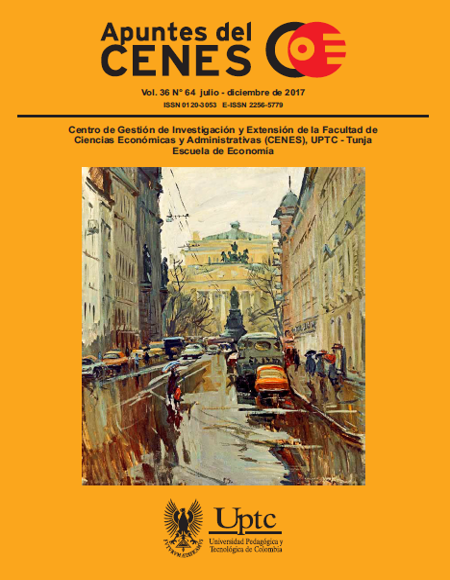Indicators of Economic Activity: A Review
DOI:
https://doi.org/10.19053/01203053.v36.n64.2017.5132Keywords:
index of economic activity, dynamic factor model.Abstract
Economic indicators are used to measure the performance of the economy when other indicators, such as gross domestic product, may not provide information about the state of the economy in real time. This article provides a review of national and international literature about the construction of indicators of economic activity. Additionally, a summary of the methodology most commonly used in the construction of indices of economic activity, Factorial Dynamic Model (MFD) and different types of estimation is offered.
Downloads
References
Alfonso, V., Arango, L., Árias, F., Cangrejo G. & Pulido, J. D. (2012). Ciclos de negocios en Colombia: 1975-2011. Banco de la República. Borradores de Economía, (651).
Alonso, J. (2006). Proyectando el producto departamental bruto caucano con un modelo de análisis factorial dinámico. Cali, Colombia: Centro de Investigaciones en Economía y Finanzas (CIENFI), Universidad ICESI.
Angelini, E., Banbura, M. & Rünstler, G. (2008). Estimating and Forecasting the Euro Area Monthly National Accounts from a Dynamic Factor Model. Journal of Business Cycle Measurement and Analysis, (953). DOI: https://doi.org/10.2139/ssrn.1282045
Arango, L., Árias, F., Flórez, L. A. & Jalil, M. (2008). Cronología de los ciclos de negocios recientes en Colombia. Lecturas de Economía, (68), 9-37.
Arango, L.E. & Melo, L.F. (2006). Expansions and Contractions in Brazil, Colombia and Mexico: A View Through Nonlinear Models. Journal of Development Economics, (80), 501-517. Retrieved from https://doi.org/10.1016/j.jdeveco.2005.02.010 DOI: https://doi.org/10.1016/j.jdeveco.2005.02.010
Aruoba, B. Diebold, F. & Scotti, Ch. (2009). Real-Time Measurement of Business Conditions. Journal of Business & Economic Statistics, 27(4), 417–27. Retrieved from https://doi.org/10.1198/jbes.2009.07205 DOI: https://doi.org/10.1198/jbes.2009.07205
Avella, M.. & Fergusson, L. (2004). El ciclo económico: enfoques e ilustraciones. Los ciclos económicos de Estados Unidos y Colombia. Banco de la República. Borradores de Economía, (284). DOI: https://doi.org/10.32468/be.284
Burns, A. F. & W. C. Mitchell (1946). Measuring Business cycles. In NBER, Studies in Business Cycle. New York: Columbia University Press.
Camacho, M.. & Domenech, R. (2012). MICA-BBVA: A Factor Model of Economic and Financial Indicators for Short-term GDP Forecasting. SERIEs, 3, 475–497. Retrieved from https://doi.org/10.1007/s13209-011-0078-z DOI: https://doi.org/10.1007/s13209-011-0078-z
Camacho, M. & Martínez-Martin, J. (2015). Monitoring the World Business Cycle. Banco de España, Working Paper, (1509). Retrieved from https://doi.org/10.1016/j.econmod.2015.09.013, https://doi.org/10.2139/ssrn.2643954, https://doi.org/10.2139/ssrn.2587001 DOI: https://doi.org/10.2139/ssrn.2643954
Camacho, M. & Pérez-Quirós, G. (2010). Introducing the Euro-STING: Short Term Indicator of Euro Area Growth. Journal of Applied Econometrics, 25(4), 663-694. Retrieved from https://doi.org/10.1002/jae.1174 DOI: https://doi.org/10.1002/jae.1174
Camacho, M., Pérez-Quirós, G. & Poncela, P. (2014). Green shoots and double dips in the euro area: A real time measure. International Journal of Forecasting, 30(3), 520-535. https://doi.org/10.1016/j.ijforecast.2013.01.006 DOI: https://doi.org/10.1016/j.ijforecast.2013.01.006
Castro, C. (2003). Yet Another Lagging, Coincident Tan Leading Index for the Colombian Economy. Departamento Nacional de Planeación. Archivos de Economía, (233).
Choi, H. & Varian, H. (2011). Predicting the Present with Google Trends. The Economic Society of Australia. Economic Record, 87(1).
Doz, C., Giannone, D. & Reichlin, L. (2011). A Two-Step Estimator for Large Approximate Dynamic Factor Models based on Kalman filtering. Journal of Econometrics, 164(1), 188-205. Retrieved from https://doi.org/10.1016/j.jeconom.2011.02.012 DOI: https://doi.org/10.1016/j.jeconom.2011.02.012
Diebold, F.X. & Rudebusch, G. (1996). Measuring Business Cycles: A Modern Perspective, Review of Economics and Statistics, 78, 67-77. Retrieved from https://doi.org/10.2307/2109848 DOI: https://doi.org/10.2307/2109848
Drechsel, K., Giesen, S. & Lindner, A. (2014). Outperforming IMF Forecasts by the Use of Leading Indicators. Institute for Economic Research. IWH Discussion Papers, (4).
Ferrara, L. & Marsilli, C. (2014). Nowcasting Global Economic Growth: A Factor-Augmented Mixed-Frequency Approach. Banque de France, (515). retrieved from https://doi.org/10.2139/ssrn.2514218 DOI: https://doi.org/10.2139/ssrn.2514218
Forni, M., Hallin, M., Lippi, M. & Reichlin, L. (2000). The Generalized Factor Model: Identification and Estimation. The Review of Economics and Statistics, 82(4), 540-554. Retrieved from https://doi.org/10.1162/003465300559037 DOI: https://doi.org/10.1162/003465300559037
Forni, M., Hallin, M., Lippi, M. & Reichlin, L. (2003). The Generalized Dynamic Factor Model: One-sided Estimation and Forecasting. Econpapers. Retrieved from http://econpapers.repec.org/paper/ssalemwps/2003_2f13.htm
Forni, M., Hallin, M., Lippi, M. & Reichlin, L. (2005). The Generalized Dynamic Factor Model. Journal of the American Statistical Association, 100(471). Retrieved from https://doi.org/10.1198/016214504000002050 DOI: https://doi.org/10.1198/016214504000002050
Forni, M., Hallin, M., Lippi, M. & Reichlin, L. (2001). Coincident and Leading Indicators for the Euro Area. The Economic Journal, 111. Retrieved from https://doi.org/10.1111/1468-0297.00620 DOI: https://doi.org/10.1111/1468-0297.00620
Giannone, D., Reichlin, L. & Small, D. (2008). Nowcasting: The Real-Time Informational Content of Macroeconomic Data. Journal of Monetary Economics, 55(4), 665-676. Retrieved from https://doi.org/10.1016/j.jmoneco.2008.05.010 DOI: https://doi.org/10.1016/j.jmoneco.2008.05.010
Golinelli, R. & Parigi, G. (2014). Tracking World Trade and GDP in Real Time. International Journal of Forecasting, 30(4), 847-862. Retrieved from https://doi.org/10.1016/j.ijforecast.2014.01.008 DOI: https://doi.org/10.1016/j.ijforecast.2014.01.008
Gómez, A.M., Sarmiento, J.I. & Fajardo, L. (2016). Advanced Global Indicator of Short and Long Term for the Economy of Cauca 1960-2014. Apuntes del Cenes, 35(62), 209-244. Retrieved from https://doi.org/10.19053/22565779.5231 DOI: https://doi.org/10.19053/22565779.5231
Hamilton, J. (1994). Time Series Analysis. Princeton, USA: Princeton University Press. DOI: https://doi.org/10.1515/9780691218632
Kalman, R. E. (1960). A New Approach to Linear Filtering and Prediction Problems. Journal of Fluids Engineering, 82(1). Retrieved from https://doi.org/10.1115/1.3662552 DOI: https://doi.org/10.1115/1.3662552
Kamil, H., Pulido, J. & Torres, J. (2010). El IMACO: un índice mensual líder de la actividad económica de Colombia. Banco de la República. Borradores de Economía, (609). DOI: https://doi.org/10.32468/be.609
Kim, M. & Yoo, J. (1995). New Index of Coincident Indicators: A Multivariate Markov Switching Factor Model Approach. Journal of Monetary Economics, 36, 607-630. Retrieved from https://doi.org/10.1016/0304-3932(95)01229-X DOI: https://doi.org/10.1016/0304-3932(95)01229-X
Koopman, S. J., Shephard, N. & Doornik, J. A. (1999). Statistical Algorithms for Models in State Space Uuing SsfPack 2.2. The Econometrics Journal, 2(1), 107-160. Retrieved from https://doi.org/10.1111/1368-423X.00023 DOI: https://doi.org/10.1111/1368-423X.00023
Litterman, R.B. (1983). A Random Walk, Markov Model for the Distribution of Time Series. Journal of Business and Economic Statistics, 1, 169-173. Retrieved from https://doi.org/10.1080/07350015.1983.10509336, https://doi.org/10.2307/1391858 DOI: https://doi.org/10.1080/07350015.1983.10509336
Marcillo, E. (2013). Un indicador líder para la actividad económica de Colombia. Departamento Nacional de Planeación. Archivos de Economía, (404).
Maurer, M.. & Uribe, M.C. (1996a). El ciclo de referencia de la economía colombiana. Departamento Nacional de Planeación. Archivos de Macroeconomía, (45).
Mejía, L. F., Monsalve, D., Parra., Pulido, S. & Reyes, A. M. (2013). Indicadores ISAAC: siguiendo la actividad sectorial a partir de Google Trends. Notas Fiscales, Ministerio de Hacienda y Crédito Público, (22).
Melo, L. F., Nieto, F., Posada, C. E., Betancourt, Y. R. & Barón, J. D. (2001). Un índice coincidente para la actividad económica colombiana. Borradores de Economía, (195).
Melo, L., Nieto, F. & Ramos, M. (2003). A Leading Index for the Colombian Economic Activity. Banco de la República de Colombia. Borradores de Economía, (243).
Nieto, F. & Melo, L.F. (2001). About a Coincident Index for the State of the Economy. Documento no publicado. DOI: https://doi.org/10.32468/be.194
Poncela, P., Senra, L. & Sierra, L. (2014). Common Dynamics of Non Energy Commodity Prices and their Relation to Uncertainty. Applied Economics. 46(30), 3724–3735. Retrieved from https://doi.org/10.1080/00036846.2014.939377 DOI: https://doi.org/10.1080/00036846.2014.939377
Poncela, P. & Ruiz, E. (2012). More is not Always Better: Back to the Kalman Filter in Dynamic Factor Models. Madrid: Universidad Carlos III de Madrid, Departamento de Estadística.
Ripoll, M., Misas, M. & López, E. (1995). Una descripción del ciclo industrial en Colombia. Banco de la República. Borradores Semanales de Economía, (33). DOI: https://doi.org/10.32468/be.33
Rozo, S. (2008). Nuevo enfoque para la construcción de un único indicador líder de la actividad económica colombiana. Ministerio de Hacienda y Crédito Público. Coyuntura Económica, 38(2), 21-62.
Salazar, D. (1996). Gráfico de un sistema de indicadores adelantados y de indicadores coincidentes. M. Maurer, M. Uribe & J. Birchenall (Eds.), El sistema de indicadores líderes para Colombia (pp. 2-88). Bogotá: DNP.
Schumacher, C. (2007). Forecasting German GDP using Alternative Factor Models based on Large Datasets. Journal of Forecasting, 26(4), 271-302. Retrieved from https://doi.org/10.1002/for.1026 DOI: https://doi.org/10.1002/for.1026
Stock, J. & Watson, M. (1989). New Indexes of Coincident and Leading Indicators. Mimeo, Cambridge MA: Evanston. DOI: https://doi.org/10.1086/654119
Stock, J. & Watson, M. (1991). A Probability Model of the Coincident Economic Indicators. In K. Lahiri & G.H. Moore (eds.). The Leading economic indicators: New approaches and forecasting record (pp. 63-90). Cambridge University Press. Retrieved from https://doi.org/10.1017/CBO9781139173735.005 DOI: https://doi.org/10.1017/CBO9781139173735.005
Stock, J. H. & Watson, M. W. (2002). Forecasting Using Principal Components from a Large Number of Predictors. Journal of the American Statistical Association, 97(460), 1167-1179. Retrieved from https://doi.org/10.1198/016214502388618960 DOI: https://doi.org/10.1198/016214502388618960
Stock, J. H. & Watson, M. W. (2004). Combination Forecasts of Output Growth in a Seven-Country Data Set. Journal of Forecasting, 23(6), 405-430. Retrieved from https://doi.org/10.1002/for.928 DOI: https://doi.org/10.1002/for.928
Stock, J. H. & Watson, M. (2011). Dynamic factor models. Oxford Handbook on Economic Forecasting. Retrieved from https://doi.org/10.1093/oxfordhb/9780195398649.013.0003 DOI: https://doi.org/10.1093/oxfordhb/9780195398649.013.0003
Vidal, P., Sierra, L., Sanabria, J. & Collazos, J. (2015). Indicador mensual de actividad económica (IMAE) para el Valle del Cauca. Banco de la República. Borradores de Economía, (900).
Downloads
Published
How to Cite
Issue
Section
License
Copyright (c) 2017 Lya Paola Sierra Suárez, Jaime Andrés Collazos-Rodríguez, Johana Sanabria-Domínguez, Pavel Vidal-Alejandro

This work is licensed under a Creative Commons Attribution-NonCommercial-ShareAlike 4.0 International License.






